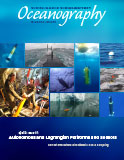Article Abstract
Where, when, and what to sample, and how to optimally reach the sampling locations, are critical questions to be answered by autonomous and Lagrangian platforms and sensors. For a reproducible scientific sampling approach, answers should be quantitative and provided using fundamental principles. This article reviews concepts and recent progress toward this principled approach, focusing on reachability, path planning, and adaptive sampling, and presents results of a real-time forecasting and planning experiment completed during February–April 2017 for the Northern Arabian Sea Circulation-autonomous research program. The predictive skill, layered fields, and uncertainty estimates obtained using the MIT MSEAS multi-resolution ensemble ocean modeling system are first studied. With such inputs, deterministic and probabilistic three-dimensional reachability forecasts issued daily for gliders and floats are then showcased and validated. Finally, a Bayesian adaptive sampling framework is shown to forecast in real time the observations that are most informative for estimating classic ocean fields and also secondary variables such as Lagrangian coherent structures.

